History
The 12th Armoured Regiment was formed from the 18th Motor Regiment and was transferred from the Australian Light Horse to the Australian Armoured Corps on 8 May 1942. [1] [2] The regiment, along with the 13th and 14th Armoured Regiments, 9th Motor Regiment and 3rd Reconnaissance Squadron, was allocated to the newly-raised 6th Armoured Brigade, itself part of the newly-converted 2nd Armoured Division. The 12th Armoured Regiment was initially based in Adelaide. [3]
In July 1942, the regiment moved to Puckapunyal with the rest of the 6th Armoured Brigade. At the Armoured Fighting Vehicles School the regiment conducted Officer and Senior NCO leadership and tactics course, prior to conducting specialised training in driving and maintenance, gunnery and wireless for each squadron. The regiment trained on M3 Grant medium tanks and M3 Stuart light tanks, with support elements equipped with a range of carriers, trucks and weapons. Upon completion of elementary training, the regiment conducted squadron and regimental exercises in the Seymour district. At the completion of these manoeuvres the 12th Armoured Regiment, and the 6th Armoured Brigade in general, was at a high standard of training and was well equipped at close to war establishment. [3] The unit achieved AIF status, with at least 65% of its members volunteering for overseas service. [2]
However, by December 1942 the strategic threat to Australia had lessened as the Japanese advance had been halted following the battles of the Coral Sea and Guadalcanal, and the Kokoda Track campaign. Consequently, it was assessed that the large numbers of armoured units created for the defence of Australia were no longer required, and the 2nd Armoured Division was ordered to disband. While elements of the 6th Armoured Brigade were reallocated to other divisions, the 12th Armoured Regiment was disbanded on 13 February 1943. [1]
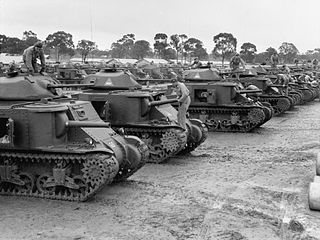
The 1st Armoured Division was an armoured formation of the Australian Army, raised in 1941 as part of the Second Australian Imperial Force (AIF) during World War II. While the Division was originally to be deployed to North Africa in late 1941, it was retained in Australia following the outbreak of the Pacific War. The 1st Armoured Division formed a key element of Australia's defences against a feared Japanese invasion and was disbanded in Western Australia in September 1943.

The Royal Australian Armoured Corps (RAAC) is a corps of the Australian Army which provides the Australian Defence Force's armour capability. Armour combines firepower, mobility, protection and networked situational awareness to generate shock action and overmatch in close combat. Armour is an essential element of the combined arms approach that is employed by the Australian Army.

The 2nd Armoured Division was an armoured formation of the Australian Army during World War II. Originally raised in 1921 as the 2nd Cavalry Division, based in Victoria and South Australia, the formation had been converted into a motor division in early 1942, before adopting the armoured designation later in the year. A Militia formation, the division undertook garrison duties in Australia and did not see combat before being disbanded in mid-1943.

The 3rd Armoured Division was an armoured unit of the Australian Army during World War II. Originally raised in 1921 as the 1st Cavalry Division, the formation had been converted into a motor division in early 1942, before adopting the armoured designation in November 1942. A Militia formation, the division undertook garrison duties in New South Wales and then Queensland and did not see combat before being disbanded in late 1943 and early 1944.
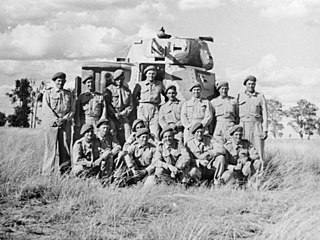
Armoured units made a relatively small, but important, contribution to Australia’s war effort during World War II. While Australia formed three armoured divisions and two independent armoured brigades during the war, Australian armoured units only saw action as independent regiments and companies supporting larger infantry formations. Early actions were fought in the Middle East by the divisional carrier regiments that supported the 6th, 7th and 9th Divisions, fighting in Libya, Egypt and Syria in 1941–42, before the Australian divisions returned to Australia in 1942–43. During the early fighting in the Pacific, there was a limited role for armoured formations, although one armoured regiment – the 2/6th – took part in the fighting around Buna–Gona in late 1942. Later in the war, though, during the Huon Peninsula, Bougainville and Borneo campaigns of 1943–45, several armoured units were used by Australian forces in the infantry support role.

The 2/4th Armoured Regiment was an armoured regiment of the Australian Army, which served during World War II. The regiment was formed in November 1942 as part of the Second Australian Imperial Force by amalgamating a number of previously existing armoured units and was disbanded in September 1946 after seeing action in New Guinea and Bougainville Island, where it provided individual squadron-group sized elements which operated in support of infantry operations against the Japanese. During its service the regiment received 10 battle honours.

The 2/9th Armoured Regiment was an armoured regiment of the Australian Army. Raised for service during World War II, the regiment was formed in August 1941 and spent most of the war in Australia. It was disbanded in early 1946 after seeing action in the Borneo campaign late in the war.
The 2/8th Armoured Regiment was an armoured regiment of the Australian Army. It was raised for service during World War II, being formed in July 1941. It deployed to New Guinea in 1943 but did not see any action before being disbanded in February 1944.

The 12th/16th Hunter River Lancers is an Australian Army Reserve cavalry regiment. It was formed on 1 May 1948, although it draws its lineage from units that were originally formed in the 1880s. It is currently a Light Cavalry unit equipped with Bushmaster Protected Mobility Vehicles. The regiment forms part of the 11th Brigade, attached to the 2nd Division and draws its members from regional centres in northern New South Wales, hence the reference to the Hunter River. Since 2000 the regiment has provided individuals as reinforcements to round-out Regular Army units deploying overseas on peacekeeping operations and in the conflicts in Iraq and Afghanistan.

The 1st Armoured Brigade was a formation of the Australian Army during World War II. The brigade was formed in July 1941, at Greta, New South Wales from volunteers for the Second Australian Imperial Force and was assigned to the 1st Armoured Division. Raised initially for service in the Middle East, following Japan's entry into the war, the brigade was assigned to the defence of Australia in case of an invasion. After garrison duties in New South Wales and Western Australia, it was disbanded in November 1944 without seeing active service, although some of its former units saw action later with other formations.

The 2nd Armoured Brigade was a formation of the Australian Army during World War II. The brigade was formed in July 1941, at Puckapunyal, Victoria, from Second Australian Imperial Force volunteers. It was assigned to the 1st Armoured Division in July 1941, with the intention of deploying it to the Middle East. However, it was reassigned to home defence following Japan's entry into the war, and was then transferred to the 3rd Armoured Division in October 1942. The brigade remained in Australia, undertaking defensive duties in Victoria and Queensland before being disbanded in January 1944. While it did not see any active service as a formation, some of its constituent units eventually took part in the campaigns on Tarakan, Labuan, Bougainville and around Aitape–Wewak in 1944–1945 after transferring to other brigades.

The 6th Australian Armoured Brigade was a formation of the Australian Army during World War II. The brigade was formed in May 1942, by the conversion of the 6th Motor Brigade and was assigned to the 2nd Motor Division. The brigade also absorbed units of the 5th Motor Brigade in June 1942. The brigade remained in Australia and did not see any active service before it was converted into the 4th Armoured Brigade in March 1943.
The 2nd Motor Brigade was a formation of the Australian Army during the interwar years and World War II. Initially raised in 1921 as the 2nd Cavalry Brigade in New South Wales, it was a part-time formation of the Militia. It consisted of three light horse regiments spread across several depots across the Hunter Valley and northern part of the state. During World War II, the brigade was mobilised for defensive duties in December 1941, and assumed positions along the northern coast to defend against a possible invasion. In early 1942, the brigade was converted into a motorised formation, and was redesignated as the 2nd Motor Brigade. In April 1943, when the threat of invasion had passed, it was disbanded and its manpower reallocated.

The 4th Motor Brigade was a formation of the Australian Army during the interwar years and the early part of the World War II. A formation of the part-time Militia, the brigade was formed in 1921 as the 4th Cavalry Brigade. At this time, it consisted of three light horse regiments based in southern and western New South Wales. During World War II, the brigade was mobilised for defensive duties in December 1941, and assumed positions along the southern New South Wales coast to defend against a possible invasion. It was converted into the 4th Motor Brigade in March 1942 when it was motorised. As a motor brigade, the 4th undertook defensive duties on the south coast of New South Wales before it was converted into an armoured formation, designated the 3rd Army Tank Brigade in May 1942.

The 3rd/9th Light Horse is a Reserve light cavalry regiment of the Australian Army based in Smithfield, South Australia. Part of the Royal Australian Armoured Corps (RAAC), the regiment is attached to the 9th Brigade, 2nd Division and currently operates G-Wagon SRV 6x6 and Bushmaster Protected Mobility Vehicles.
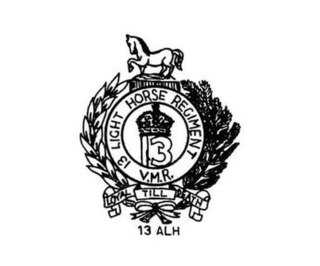
The 13th Light Horse Regiment was a mounted infantry regiment of the Australian Army during the First World War. The regiment was raised in March 1915, and eventually assigned as the mounted regiment for the Australian Corps. During the war the regiment fought against the forces of the Ottoman Empire, at Gallipoli, and against the German Empire on the Western Front. For its role in the war the regiment was awarded twelve battle honours. In 1921, it was later re-raised as a part-time unit of the Citizens Forces, and was briefly amalgamated with the 19th Light Horse. During the Second World War, the regiment was converted into an armoured regiment, designated the "13th Armoured Regiment", although it was disbanded in late 1943 without seeing action.

The Australian Army has used tanks from after the First World War, through the interwar period, the Second World War, the Cold War and to the present day. Throughout this period the Army has primarily been a light infantry force, with its tanks mainly being used in the direct support role. The Australian Army's tanks have seen combat during the Second World War and the Vietnam War, where they proved successful despite some of the designs employed being considered obsolete. The first Australian tanks were a small number of British medium and light tanks which were operated mainly for training purposes during the 1920s and 1930s.

The 14th Armoured Regiment was a unit of the Australian Army, which served during World War II. The regiment was formed in May 1942 as part of the 6th Australian Armoured Brigade. It was originally a Militia unit which originated from the 17th Light Horse Regiment. It was disbanded in early 1943 without seeing combat.
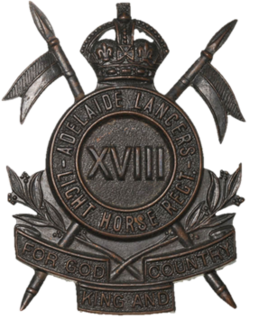
The 18th Light Horse Regiment was a Citizens Military Force unit of the Australian Light Horse, formed during the post-World War I reorganisation of the Australian Army. The regiment traces its origins back to the militia cavalry regiments raised in the colony of South Australia, such as the Adelaide Cavalry Squadron, the Adelaide Mounted Rifles and the South Australian Mounted Rifles. This is a different unit to the pre-World War I, 18th Australian Light Horse.
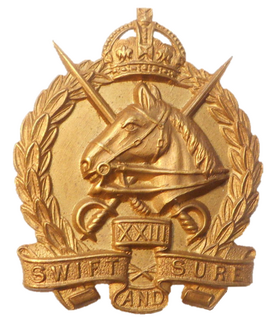
The 23rd Light Horse Regiment (Barossa) was a Citizens Military Force (CMF) unit of the Australian Light Horse, formed during the 1912 reorganisation of the Australian Army. The regiment traces its origins back to the militia cavalry units raised in the colony of South Australia, specifically the South Australian Mounted Rifles.

















